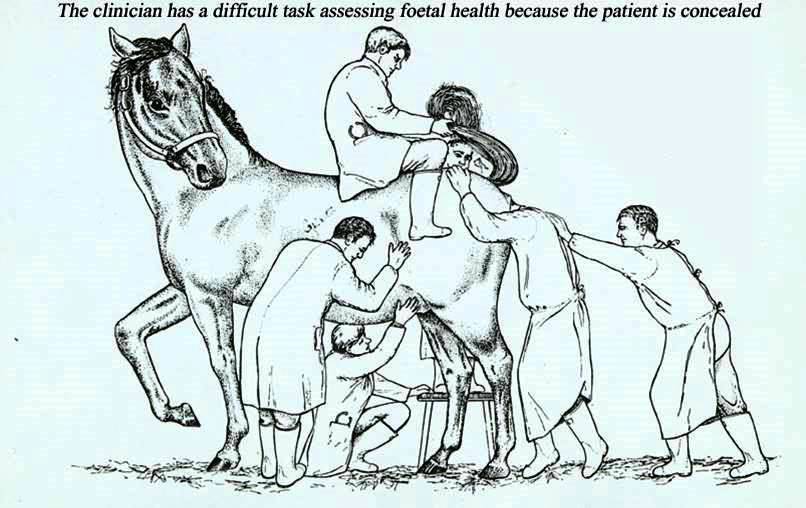Breeders Back Artificial Insemination
Hunter Valley News by Brian Russell (c. 1990)
Featured Image: The ‘miasma’ of equine (thoroughbred) reproduction courtesy of Professor Twink Allen
This headline might have evoked a trenchant response if it had appeared in the major print media of the day? As it was it flew under the radar. The ‘heavyweights’ in the thoroughbred industry have always ignored the opinions of the minions! Immutable imperious legality rules OK; and always has. The anachronistic and archaic ‘rubrics’ as decreed by the major law makers of yesteryear, the English Jockey Club/Stud Book plus the American equivalent(s) laid down the road map. Essentially it hasn’t wavered despite remarkable scientific progress in parentage verification and other technological advancements. Small adjustments have been made such as allowing some latitude in ‘early’ birth dates. Some very courageous breeders such as Bruce McHugh have been brave and bold enough to mount a significant challenge. It’s a very solid ‘brick wall’. It’ seems ludicrous and absurd to be floating mares around the TB Studs of the Upper Hunter (and elsewhere) seeking to cover mares at midnight because of overbooked stallions? Natural mating occurs at dawn and dusk. The overarching premises appear to be avarice and cupidity plus hegemonic control. I rest my case.
Brian Russell writes:
The stallions may not be happy with the idea, but the general consensus among thoroughbred breeders at a seminar held at Scone, June 30, was that the use of artificial insemination in a controlled manner could be beneficial to the industry.
At the moment AI is not allowed world-wide in thoroughbred breeding, although it is used in the standard bred, cattle and sheep industries.
The seminar which was held at the new Scone TAFE Centre, was attended by nearly 100 people at the invitation of the NSW Bloodhorse Breeders’ Association, the Hunter Valley Bloodhorse Breeders’ Association, the Hunter Valley Equine Research Foundation and the Upper Hunter Branch of the NSW Division of the Australian Veterinary Association.
The subject of the seminar was:
“As breeders, should we review our support for the ban on artificial insemination in the thoroughbred industry as an alternative to natural coverings?”
Speakers at the seminar were: Professor W R (‘Twink’) Allen BVSc, PhD, DESM, MRCVS, Director of the Thoroughbred Breeders’ Association (UK) Equine Fertility Unit; Jim Joel Professor of Equine Reproduction, University of Cambridge, England; Dr John Digby, BVSC, MBA, Keeper of the Australian Stud Book; Dr Angela Begg, BVSc, PhD, Dip Vet Path, Hunter Equine Research Centre Scone Diagnostic Veterinary Laboratory; and Dr Angus McKinnon, BVSc.
The holding of the seminar followed a resolution which has been passed at a meeting of the NSW Bloodhorse Breeders’ Association in April which read:
- In view of the fundamental importance of parentage in bloodstock and the issues that have been raised, we should obtain all relevant documentation in great detail on the whole issue involving artificial insemination
- Before any final decision is reached there should be exhaustive discussion and the opinions of the membership in relation to the subject should be extensively canvassed.
One of the main instigators of the discussion, Dr Digby, delivered two papers at the seminar under the headings:
“The likely impact of dual hemisphere serving (shuttle) stallions on the stallion population and covering patterns in Australia” and:
“Should we review our support for the ban on artificial insemination as an alternative to natural coverings?”
Afterwards the reaction of the audience to a question as to the use of AI was tested by show of hands. They indicated strong support for the use of AI as a management tool but for use on the stud farm only. There was no support for the use of frozen semen and its transportation to point of use.
In a question on whether stallions should have limited coverings (either natural or by AI), the gathering was given the choice of the number of mares a stallion should be allowed to cover in the southern hemisphere breeding seasons: 70 -80, 80-90, 90-100, 100 or more. The strongest support was given to the 90-100 bracket.
The opinion reflected only the feelings of those attending the seminar and cannot be construed as the response of the industry as a whole. While AI is considered overall to be a useful tool, breeders felt more into motion, particularly concerning genetics, has to be researched and published.
Mr Digby is to organise a discussion paper, including evidence from geneticists, which will be distributed to breeders. This will be followed by a questionnaire which should indicate the general feeling as to whether or not AI should be introduced if possible.










